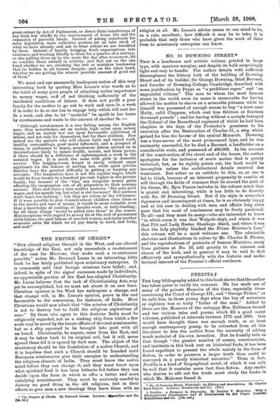NO. 10 DOWNING STREET.*
This is a handsome and artistic volume, printed in large type, with spacious margins, and despite its bulk snrprigingly light and easy to handle. The author details with sufficient thoroughness the history both of the building of Downing Street and of its builder, Sir George Downing, third Baronet, and founder of Downing College, Cambridge, described with some justification by Pepys as "a perfidious rogue" and "an ungrateful villaine." The man to whom the most famous street in the world owis its name is memorable for baying allowed his mother to starve on a miserable pittance while he himself was possessed of enough means to buy "a town near Rally, calla Clappum, which cost him thirteen or fourteen thousand pounds"; and for having without a scruple betrayed the Colonel of the Roundhead regiment of which he had been chaplain in the days of the Protector's greatness to his execution after the Restoration of Charles IL, a step which gained for him the favour of the cynical Monarch. Downing was a time-server of the most pronounced type, and he was eminently successful, for he died a Baronet, a landholder on a considerable scale, and possessed of £80,000. In his account of the construction of the street and of the house, the author apologises for the inclusion of much matter that is purely technical; but, as he rightly points out, the book would be incomplete unless the architectural details received dim treatment. But either as an antidote to this, or, as one is led to think, because of an inherent propensity to ramble at will through the fields of romance that lie around the path of his theme, Mr. Eyre Pascoe includes in his volume much that is quaint and interesting, while it has little to do directly with No. 10 Downing Street. But if his style is somewhat digressive and inconsequent at times, he is so obviously happy and at his ease in dealing with men and affairs long since gone that his want of conciseness may be freely pardoned. To all—and they must be many—who are interested to know "in which room it was that Walpole slept, and where it was that Pitt and Lady Hester Stanhope dined, and where it was that the lady playfully blacked the Prime Minister's face," this volume will be a most welcome one. The admirable sketches and illustrations in colour by Mr. Charles E. Flower, and the reproductions of portraits of famous Ministers, many from pictures at No. 10, add greatly to the interest and charm of the book, and in general it may be said to deal effectively and sympathetically with the historic and archi. tectural interest of the Premier's official residence.










































 Previous page
Previous page